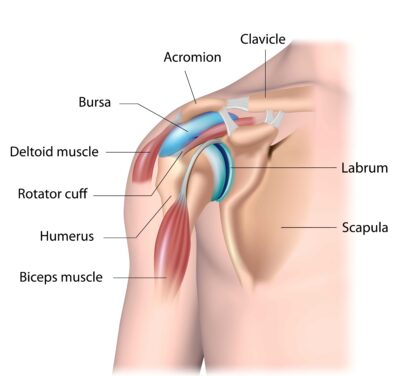What is the shoulder made up of?
The shoulder joint is one of the largest and most complex joints in the human body. It is also the most flexible joint in the body. The anatomy of the shoulder is made up of three small joints, not just one large shoulder joint. These are called the acromioclavicular, sternoclavicular and glenohumeral joints. The glenohumeral joint is the major joint of the shoulder and is also called the ball and socket joint of the shoulder. Made up of three bones, the scapula (shoulder blade), humerus (arm bone) and clavicle (collar bone), the bones work within the joints, using a network of tissues to help the joint rotate, lift, bend and move the arm. If any of these structures stop functioning or is causing pain with normal activity, Dr. Armando Vidal, MD, Shoulder Specialist serving patients in Vail, Aspen and the surrounding Denver, Colorado communities can help diagnose and treat conditions of the shoulder.

What are the important structures in the shoulder joint?
Important structures within the shoulder joint help it to move and give it strength as well as flexibility. Shoulder stability is an important part of a properly functioning shoulder joint and is achieved with the help of ligaments, tendons, muscles and cartilage. These soft tissues connect, cushion and rotate the shoulder joint and make it strong and stable through all of the shoulder’s demands.
A few important structures that make up the shoulder joint are:
Rotator Cuff – The rotator cuff’s job is to hold the head of the humerus (upper arm bone) firmly within the shallow socket of the shoulder. It is made up of a group of muscles and tendons that contribute to shoulder strength and stability. The rotator cuff is analogous to the reins on a horse. They do not power the shoulder but help to guide it and allow the major muscles around the shoulder (deltoid, pec major, trapezius, latissimus) to do their job. When the rotator cuff is injured, the shoulder does not function properly.
Labrum – The shoulder labrum is a ring of cartilage that surrounds the socket of the shoulder. Its main function is to serve as the attachment for ligaments and tendons and deepen the shallow socket. Injuries to the labrum can result in pain and/or instability
Bursa – These small, fluid-filled sacks cushion and lubricate the rotator cuff tendon. They are located between the bone and the surrounding soft tissue.
Deltoid Muscle – The strongest and largest muscle of the shoulder, provides the strength to lift the arm.
Biceps Tendon – This tendon is where the biceps muscle attaches to bone. It begins at the top of the shoulder socket and allows the elbow to bend and the forearm to rotate.
Isn’t the shoulder just one big joint?
The shoulder joint is actually made up of three separate joints. The glenohumeral joint is the joint most people associate as the shoulder joint. It is formed where the head of the humerus fits into a shallow, cup-like socket called the glenoid, in the scapula. The joint known as the acromioclavicular joint is located at the highest point of the scapula (called the acromion) where it meets the clavicle and the glenohumeral joint. Together, these specialized joints allow for movement of the shoulder.
The final joint within the shoulder is called the sternoclavicular joint or the SC joint. It is classified as a plane-style synovial joint and is located where the clavicle and the sternum meet. It is the only joint that connects the arm to the rest of the body.
What is the Scapulothoracic Joint?
The ST joint, or scapulothoracic joint in the shoulder is not a “true” joint because it does not have any of the usual joint characteristics. It is an articulation of the scapula with the thorax (chest wall) and depends on the strength of the AC and SC joints. (Acromioclavicular and sternoclavicular) and the myriad of muscles around it.
The shoulder’s wide range of motion, as well as the demands placed on the joint from normal work and play make it susceptible to injury. Any shoulder injury or pain should be evaluated by Dr. Armando Vidal, Shoulder Specialist serving patients in Colorado. He can diagnose and treat shoulder conditions and has a proven track record for returning patients to their normal activities.
Locations
180 S Frontage Rd W
Vail, CO 81657
226 Lusher Court
Ste 101
Frisco, CO 80443
322 Beard Creek Road
Edwards, CO 81632


